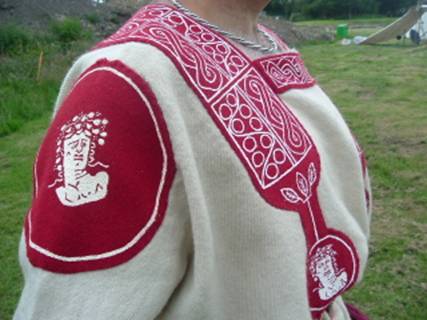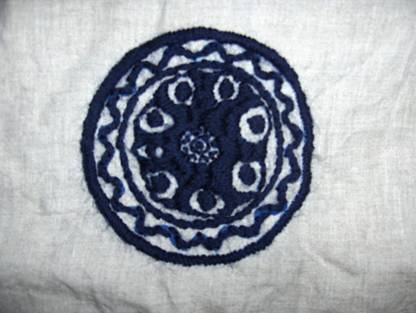Old Tunics, New Looks
Painting Roman Tunics
by John Conyard
 Late Roman re-enactment is relatively new compared to the recreation of the early Imperial Roman army. The hardest part of a successful impression is, and always will be the tunic. Many individuals are making great strides in recreating the tunics of the past. But is sometimes harder for a society to keep up.
Late Roman re-enactment is relatively new compared to the recreation of the early Imperial Roman army. The hardest part of a successful impression is, and always will be the tunic. Many individuals are making great strides in recreating the tunics of the past. But is sometimes harder for a society to keep up.
The Comitatus first tunic pattern holds a special place in my heart. We all looked so identical! Slowly research lead us in other directions and that diversity of look is to be applauded. I would always recommend that new tunics be based on original examples. But please remember surviving examples are often from Egypt, a world away from North East England, and made of linen or cotton and wool mixes, very different to woollen tunics worn in the north.
For the past few years tunics have been improving. The use of patterned clavii and roundels are becoming more common. By far the easiest way of improving old tunics is the application of material paint to re-create an authentic pattern on the clavii and roundels.
Material paint is easily available in art or craft shops. Iíve painted many medieval cloth badges and 17th century ensigns in my time. You will need a material paint that can be applied to wool, not just silk, cotton or linen. This is harder to find, but Liquitex, concentrated Acrylic Artist Colour, medium viscosity, works very well. I got some from the art shop at the bottom of the Shambles in York, and two 59ml bottles enabled me to cover one large tunic. You could also try www.liquitex.com.
 You will probably have a flat colour of wool attached to an off-white tunic. Therefore I would apply just one colour, soft white beige, to the clavii and roundels. It should look like a single colour of wool has been woven into the off white wool. Try and base your pattern on an existing example. I used the clavii pattern on the dalmatic in the Constantine exhibition, and the roundels on fragments of curtain depicting the god Bacchus. Well, it seemed appropriate.
You will probably have a flat colour of wool attached to an off-white tunic. Therefore I would apply just one colour, soft white beige, to the clavii and roundels. It should look like a single colour of wool has been woven into the off white wool. Try and base your pattern on an existing example. I used the clavii pattern on the dalmatic in the Constantine exhibition, and the roundels on fragments of curtain depicting the god Bacchus. Well, it seemed appropriate.
I applied the paint using an ď00Ē sable paintbrush. Iím sure that a nylon brush may have worked as well, but sable brushes are the best. Two coats will be needed to give a good finish. When the paint is dry you need to fix it on the wool. Cover the painted material with a cloth and dry iron over it. Ensure that if you fold the cloth, no paint cracks of chips.
It will not take long to do, but the improvement is startling. Good luck!
The views of individual members expressed on this website do not necessarily reflect the view of the group as a whole. Photos/Images: These are normally copyright of an individual Comitatus member. Use of an image for educational or research purposes will be happily granted, if permission is sought first, and we can secure an acknowledgement, and higher resolution images can often be arranged for publication or display! Please e-mail first.